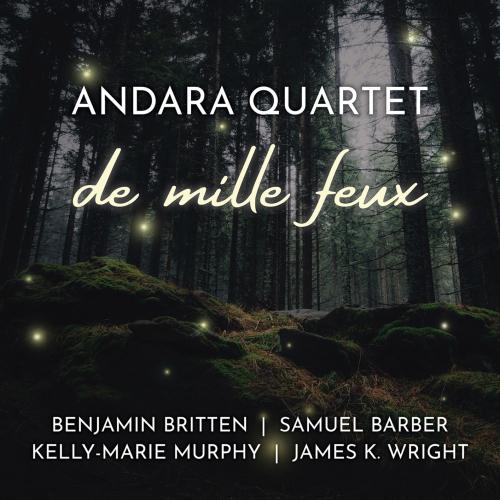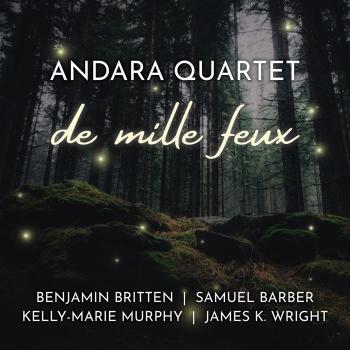
De mille feux Quatuor Andara
Album info
Album-Release:
2022
HRA-Release:
04.11.2022
Label: Leaf Music
Genre: Classical
Subgenre: Chamber Music
Artist: Quatuor Andara
Composer: Samuel Barber (1920-1981), Eldon Rathburn (1916-2008), James Wright (1959), Benjamin Britten (1913-1976), Dominique Beauséjour-Ostiguy
Album including Album cover
- Benjamin Britten (1913 - 1976): String Quartet No. 1 in D Major, Op. 25:
- 1 Britten: String Quartet No. 1 in D Major, Op. 25: I. Andante sostenuto - Allegro vivo 09:42
- 2 Britten: String Quartet No. 1 in D Major, Op. 25: II. Allegro con slancio 02:55
- 3 Britten: String Quartet No. 1 in D Major, Op. 25: III. Andante calmo 11:52
- 4 Britten: String Quartet No. 1 in D Major, Op. 25: IV. Molto vivace 04:03
- Samuel Barber (1910 - 1981): String Quartet in B Minor, Op. 11:
- 5 Barber: String Quartet in B Minor, Op. 11: II. Molto adagio 07:39
- Kelly-Marie Murphy (b. 1964): Dark Energy:
- 6 Murphy: Dark Energy 08:56
- James K. Wright (b. 1959): String Quartet No. 1 "Ellen at Scattergood":
- 7 Wright: String Quartet No. 1 "Ellen at Scattergood": I. Introduzione, fugato e dolce cantabile 06:38
- 8 Wright: String Quartet No. 1 "Ellen at Scattergood": II. Molto sostenuto e expressivo 04:49
- 9 Wright: String Quartet No. 1 "Ellen at Scattergood": III. Scherzo-Tarantella 02:43
- 10 Wright: String Quartet No. 1 "Ellen at Scattergood": IV. Adagio e rondo ballabile 06:03
Info for De mille feux
De mille feux sees James Wright in collaboration with the Andara Quartet — Marie-Claire Vaillancourt (violin), Jeanne Côté (violin), Vincent Delorme (viola), and Dominique Beauséjour-Ostiguy (cello) — to realize four unique works. The first, written by Benjamin Britten at the age of 28, String Quartet No. 1, Op. 25 is undoubtedly the most luminous of his four string quartets. The Andante sostenuto begins with one of the most remarkable opening pages in English chamber music: the violins and viola are seemingly suspended—weightless, pianissimo and molto vibrato—at a stratospherically high pitch, like a trail of twinkling, distant stars. The remainder of the work takes us on a series of voyages between earth and the cosmos, between the rooted energy of the ground under our feet, the impalpable shimmering of the ether in which we seem to bathe, and the human aspirations that travel between the two.
In 1936, Samuel Barber completed the String Quartet in B minor, Op. 11 (his only string quartet), and he arranged its Adagio movement for string orchestra later the same year. The quartet was premiered by the Pro Arte Quartet on December 14, 1936, at the Villa Aurelia, at the end of Barber’s Prix de Rome residency there. In its arrangement for string orchestra, the Adagio for Strings ultimately became Barber’s best-known work. The power of its pathos and passion is such that the work has often been performed in the United States during times of national trauma. It was first heard in 1945 during the broadcast funeral services for President Franklin Delano Roosevelt, just three weeks prior to Germany’s surrender at the end of the Second World War.
Dark Energy, from Kelly Marie-Murphy, was commissioned by the Banff International String Quartet Competition and the CBC as the required piece for the 2007 competition. In a single movement, the quartet opens softly and simply. It explores and displays a variety of string colours and techniques, and it continually gains momentum, eventually consuming itself with its own propulsion. The piece is virtuosic in every way, yet there are flexible moments in which each performance can yield a different interpretation.
The final piece is James K. Wright’s own String Quartet No. 1 (“Ellen at Scattergood”), a work commissioned by Carleton University professor David Cray as a gift for his wife, Ellen, in celebration of their life together at their cottage on Lac Scattergood, Quebec. Some of the descriptors that listeners have ascribed to the quartet’s four movements—including joyfulness, romance, playfulness, celebration, energy, vigor, drama, transcendence, nostalgia, serenity, peace, and tranquility—result from Wright’s attempt to capture the many moods and textures of David and Ellen’s life at their cottage. American composer Dr. John Cornelius II writes: “Ellen at Scattergood is a really decisive string quartet with attitude! The pacing of the movements really allows the listener to get inside the piece, and it takes traditional forms and genres (Tarantella, Waltz, Rondo) and turns them on their ear. This is a brilliantly sophisticated work that has nothing to prove, except its composer’s audacity.”
Quatuor Andara:
Marie Claire Vaillancourt, violin
Richard Zheng, violin
Vincent Delorme, viola
Dominique Beauséjour-Ostiguy, cello
Quatuor Andara
It was in September 2014, around Maurice Ravel's String Quartet in F major, that the members of the Andara Quartet - Marie-Claire Vaillancourt (violin), Jeanne Côté (violin), Vincent Delorme (viola) and Dominique Beauséjour-Ostiguy (cello) - met for the first time at the Conservatoire de musique de Montréal under the tutelage of Denis Brott. Since then, their passion, their dynamism, the quality of their playing and their unique repertoire have earned them critical acclaim across Canada and on the international scene.
The Andara Quartet is the University of Montreal's Junior Ensemble-in-Residence from 2021 to 2023, a Banff Centre for Arts and Creativity Ensemble-in-Residence, and the Ottawa International Chamber Music Festival's 2019 Career Development Residency Ensemble. Winners of several first prizes at national competitions between 2015 and 2019, the quartet members participated in the first ever Strijkkwartet Biennale Amsterdam where they performed for members of the Emerson Quartet, Cuarteto Quiroga, Signum Quartet and Danel Quartet, among others. Numerous other high-profile international clinics have allowed them to work with musicians such as Günter Pichler, Mathieu Herzog and the Talich String Quartet at the 2018 edition of MISQA, the St. Lawrence String Quartet in Stanford (CA) in the summers of 2018 and 2017, Johannes Meissl and the Shanghai Quartet at the Pablo Casals Festival in France in 2017 as well as Barry Shiffman and Mark Steinberg at the Banff Chamber Music Residency in 2016. The group released its first-ever self-produced album À travers les Amériques in the summer of 2021.
This album contains no booklet.










